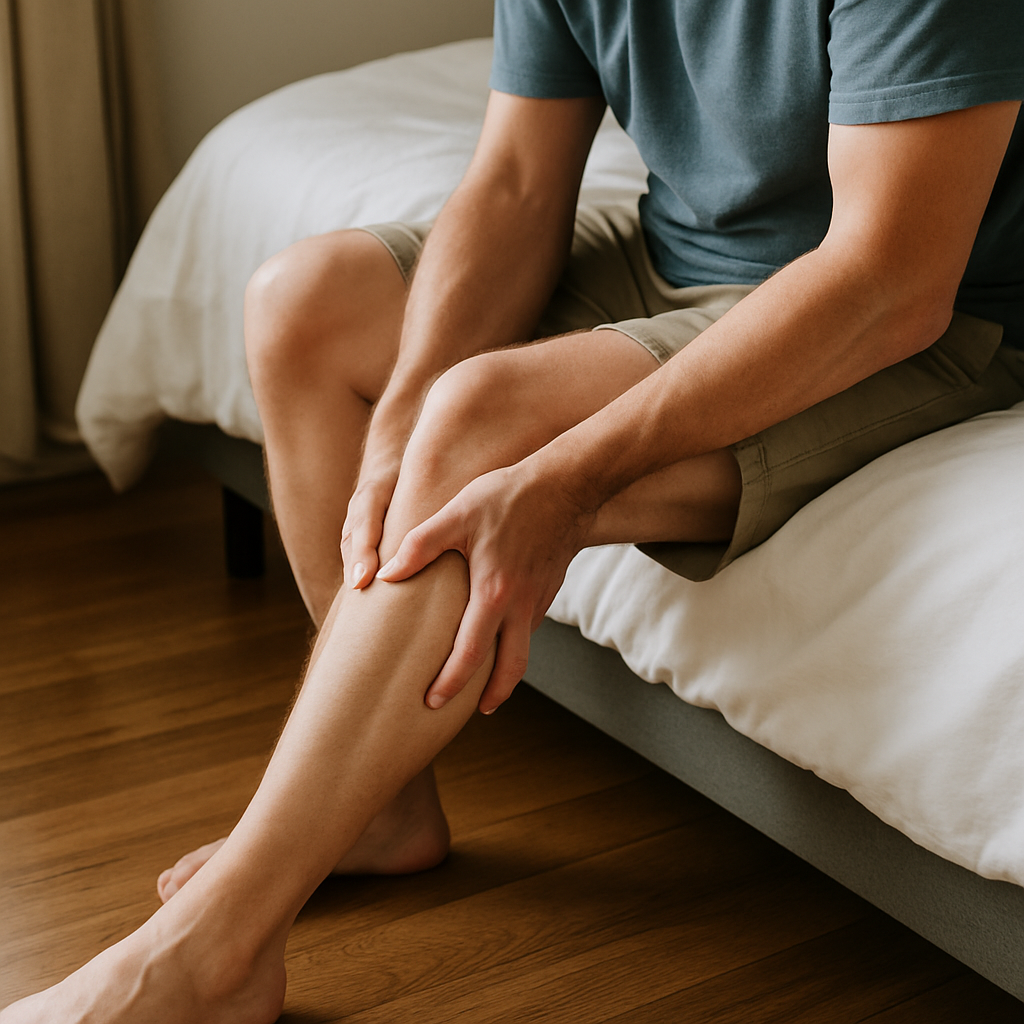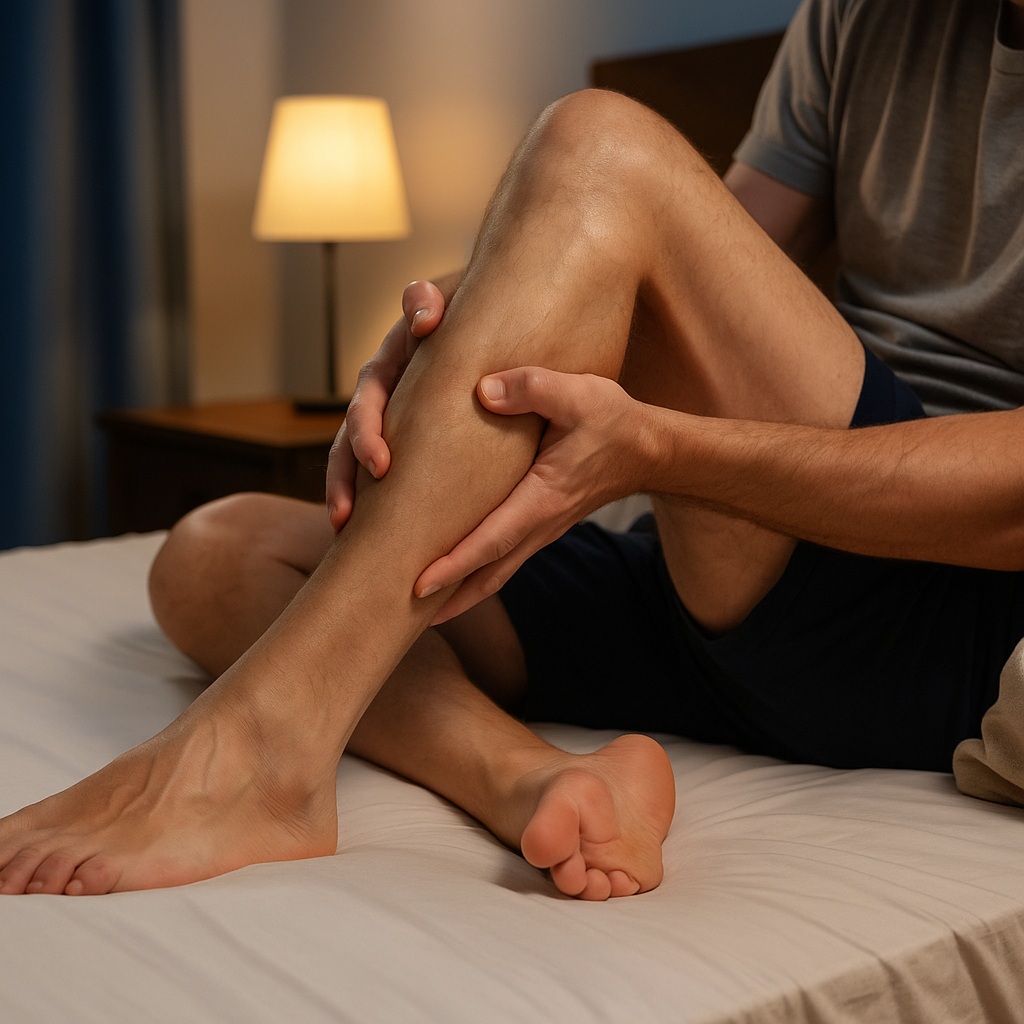Ask Ayurvedic doctor a question and get a consultation online on the problem of your concern in a free or paid mode. More than 2,000 experienced doctors work and wait for your questions on our site and help users to solve their health problems every day.
Shop Now in Our Store
When to Worry About Leg Cramps: Ayurvedic View on Causes and Relief

You ever wake up in the middle of the night—dead asleep one minute, and the next you’re flailing in pain because your calf decided to seize up like it’s training for a medieval torture reenactment? Yeah, leg cramps. Especially those relentless leg cramps at night—the so-called nocturnal leg cramps—can go from annoying to downright alarming real quick. And here’s the kicker: sometimes, they’re just a harmless blip. Other times? A flashing neon sign from your body screaming, “Hey, something’s off!”
In Ayurveda, leg cramps aren’t just physical. They’re often a whisper (or a yell) from your doshas—Vata, Pitta, and Kapha—telling you your inner balance is skewed. We’ll dig into that. We’ll also look at when to worry about leg cramps versus when to just roll over and go back to sleep. And yes, we’ll talk real solutions—leg cramp relief that doesn’t involve popping painkillers like candy.
So whether you’re dealing with severe leg cramps, mild spasms, or just want to understand why your legs keep freaking out at 3 a.m., read on. There's more here than you might expect.
Common Causes of Leg Cramps
Before we start spiraling into worst-case scenarios (Google has probably already convinced you it’s something deadly), let’s take a step back. Most leg cramps, even the brutal ones, have pretty mundane causes. Doesn’t mean they’re not a pain—literally—but understanding the root can help a lot.
Dosha Imbalance, Poor Circulation, and Lifestyle Triggers
In Ayurvedic terms, Vata dosha is the main troublemaker when it comes to cramps. Vata governs movement in the body, so when it's out of whack—maybe due to stress, dehydration, or irregular routines—it shows up in weird muscular spasms and nerve twitchiness.
Poor circulation is another biggie. If you're sitting all day, crossing your legs for hours, or wearing tight clothes, blood flow gets sluggish. And then come the cramps. Add in things like cold weather (another Vata aggravator) or overexerting during workouts, and you've got a recipe for those awful night leg cramps.
And oh—the modern lifestyle. Caffeine, alcohol, late-night snacking, Netflix binges until 2 a.m.—all those mess with your body's rhythm and hydration. None of that helps when your muscles are trying to chill.
Nutritional Deficiencies and Sleep Disorders
Here’s where science and Ayurveda shake hands. Lack of magnesium, potassium, calcium—these are well-documented leg cramp causes. Ever heard someone say, “Eat a banana for cramps”? That’s not just old wives’ wisdom. It’s about restoring balance.
And then there’s sleep. If you're tossing and turning or dealing with conditions like sleep apnea, your muscles don’t rest right either. Combine that with poor hydration, and boom—leg cramps at night, again and again.
Weirdly enough, even medications—like diuretics or statins—can make cramps worse. So if you’re on any prescriptions and suddenly your legs are staging nightly protests, it might be worth a deeper look.

When to Worry About Leg Cramps?
Alright, so we’ve talked about the usual suspects. But what if the cramps don’t let up? Or what if they feel different—sharper, more frequent, weirdly timed? This is where we shift gears from “eh, it happens” to “okay, let’s not ignore this.” Because while most cramps are harmless, sometimes they’re waving a red flag you don’t want to miss.
Warning Signs of Severe or Chronic Issues
Here’s one big clue: frequency. If you’re dealing with night leg cramps more than a couple times a week—and they’re intense enough to mess with your sleep or your day—it’s time to investigate.
Same goes if they’re severe leg cramps that don’t let up quickly. You know the kind. You’re limping the next day. Or worse, you feel a knot or swelling where there shouldn't be one. That’s not just your average muscle protest—that’s something deeper.
Another red flag? If the cramps come with numbness, tingling, or weakness in the leg. That combo can point to nerve issues. Not always catastrophic, but not something to shrug off either.
Also, if you’re not super active and suddenly your legs are cramping like you just ran a marathon—especially at night—that’s not typical. The body usually gives you clues when something’s brewing under the surface.
Oh, and here's a strange one that most people don't realize: cramping that starts only in one leg. Asymmetry in symptoms? That's another sign to not just stretch it out and hope for the best.
When Leg Cramps May Signal a Deeper Problem
This is where it gets serious. Leg cramps causes that fall into the "needs medical eyes on it" category include things like:
-
Peripheral artery disease (PAD): That’s where arteries in your legs get narrowed, and muscles don’t get enough blood. Cramping when walking (claudication) is a classic sign.
-
Nerve compression: Think spinal stenosis or a slipped disc pressing on a nerve. Can feel like cramping but it’s really the nerve freaking out.
-
Electrolyte imbalance from kidney issues or liver disease. Sometimes your kidneys aren’t clearing stuff properly, and your whole chemistry goes sideways.
-
Diabetes: Yup, it’s a sneaky one. Nerve damage from high blood sugar can show up as persistent cramps, especially at night.
And then the really scary (but rare) one: blood clots. If your leg is cramping, swollen, warm to the touch, or red—especially if it came out of nowhere—that’s not a regular cramp. That’s potentially dangerous leg cramps territory. Don’t wait. Get it checked.
That said, don’t panic every time your calf twitches. It’s about patterns and intensity. One random charley horse after a workout? Probably fine. A pattern of cramps with other weird symptoms? Time to talk to someone in a white coat.

Ayurvedic Remedies and Relief Practices for Leg Cramps
Okay, let’s say you’re not in panic mode. The cramps are annoying, maybe even brutal, but manageable. What now? Honestly, Ayurveda has been addressing stuff like this for centuries, long before anyone had magnesium tablets or electrolyte powders. So if you're craving something more holistic than a heat pad and ibuprofen, here’s where it gets interesting.
Herbal Oils, Stretching, and Warm Baths
Ayurveda’s first go-to? Abhyanga—daily oil massage. Not some fancy spa ritual (though, hey, nothing wrong with that), but a real, regular self-massage using warming oils like sesame or Mahanarayan oil. This isn’t just about relaxing your muscles—it’s about balancing Vata dosha, which governs movement, nerves, and... cramping.
Warm baths also work wonders. Throw in a handful of Epsom salts—magnesium-rich—and soak it out. Follow up with stretching. Not crazy intense yoga flows, but gentle, sustained stretches targeting calves, hamstrings, and the lower back. Do it before bed. Seriously—it works.
And then there’s this old Ayurvedic hack I swear by: dry ginger and turmeric paste applied locally for 10-15 minutes. It warms, soothes, and improves circulation. Just don’t fall asleep with it on unless you want orange sheets forever.
Diet Adjustments and Hydration Support
Here’s where things get less glamorous but more effective. If you’re chronically dehydrated (and let’s be real, a lot of us are), no amount of turmeric is going to save you. Sip warm water throughout the day. Add a pinch of rock salt and lemon if you’re losing a lot of fluids.
Diet-wise, think potassium-rich foods like bananas, sweet potatoes, dates, and coconut water. Also—don’t skip ghee. Seriously. Good fats help absorb minerals and lubricate the body internally, easing Vata issues like—you guessed it—nocturnal leg cramps.
Ayurveda also suggests herbs like Ashwagandha, Shatavari, and Dashamoola to build overall muscle tone and nervous system resilience. But check with a practitioner first—your dosha mix matters.
Conclusion
So... when do you worry about leg cramps, and when do you just sigh, stretch, and go back to sleep? It really depends on context. Most leg cramps at night are harmless, a side effect of modern life, stress, and maybe forgetting to drink enough water. But if they’re chronic, intense, or come with other weird symptoms? Listen to your body. It’s smarter than we give it credit for.
And don’t underestimate old-school wisdom. Ayurveda offers real relief when you’re consistent. Oils, herbs, food—it’s slow medicine, but it sticks.
Oh, and maybe stop doom-scrolling leg cramp symptoms at 2 a.m. Been there. Doesn’t help.
FAQs
What disease starts with leg cramps?
Peripheral artery disease, diabetes, and some neurological disorders can start with leg cramps. If the cramps are persistent or paired with numbness or swelling, consult a doctor.
What can be mistaken for leg cramps?
Nerve pain, muscle strains, or even restless leg syndrome can feel like cramps. Blood clots too—though those come with swelling, warmth, and redness.
How can I tell the difference between a leg cramp and a blood clot?
Leg cramps usually resolve quickly and feel like a muscle spasm. Blood clots may cause steady pain, swelling, and warmth in the leg. If you’re unsure, don’t wait—seek medical help immediately.
This article is checked by the current qualified Dr Sujal Patil and can be considered a reliable source of information for users of the site.

